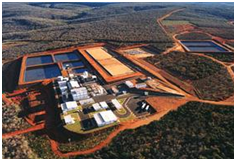
The project
Since 2000, state-owned Nuclear Industries of Brazil (INB) has been exploring uranium ore in Caetité, a municipality in the semi-arid region of Bahia, Brazil. The only operational mine in Brazil, the Caetité mine aims to provide fuel for two Brazilian nuclear power plants. The amount of uranium ore is estimated at 100,000 tons and annual production capacity of uranium concentrate (also known as yellow cake) is nearly 400 tons (MME/EPE, 2007).
The uranium is extracted from the ground by open pit mining and removed by heap leaching. First the ore is crushed, heaped, and then irrigated with a sulphuric acid solution to remove the uranium. Next, the uranium concentrate is made by the process of solvents extraction, followed by separation by precipitation and drying. Finally the uranium oxide or uranium concentrate is packaged in drums to be sent to Europe for conversion and enrichment.
INB’s major shareholder is the Nuclear Energy National Commission (CNEN), which is the Brazilian regulatory agency for nuclear energy. In Brazil, CNEN is also responsible for regulating and promoting nuclear energy activities.
The city of Caetité has about 47,000 inhabitants and is situated in the southwest part of Bahia, nearly 760 kilometres (472 miles) from its capital Salvador. The mine is located 40 kilometres (25 miles) from downtown Caetité, in Lagoa Real, and surrounded by small farming communities.
Click here for the factsheet (4 pages): FS_020_Caetite

The project ENVJUSTICE has received funding from the European Research Council (ERC) under the European Union’s Horizon 2020 research and innovation programme (grant agreement No. 695446)